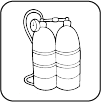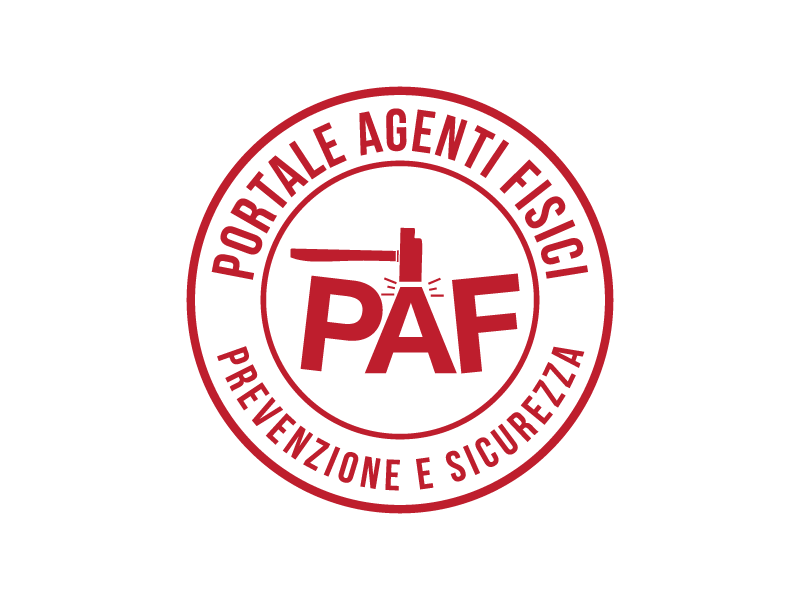Description of risk from hyperbaric atmospheres
INDEX:
WHAT ARE HYPERBARIC ATMOSPHERES?
WORKERS EXPOSED TO HYPERBARIC ATMOSPHERES are all those persons who work under hyperbaric conditions, i.e., in environments where the atmospheric pressure is at least 10% higher than at sea level.
The specific risk factor for exposure to hyperbaric atmospheres was introduced by Legislative Decree 81/08. This aspect was included as a physical risk factor in Title VIII:
Article 180 - Definitions and Field Of Application
1. For the purposes of this Legislative Decree, what is meant by physical agents are any artificially produced noise, ultrasound, infrasound, mechanical vibrations, electromagnetic fields or optical radiation and microclimate or hyperbaric atmospheres that may create risks for the health and safety of workers.
Exposure to hyperbaric environments can cause both acute and chronic effects (barotrauma, poisoning from inhaled gas or decompression sicknesses), with more or less severe consequences ranging from skin irritation to death. Symptoms appear either during or subsequent to exposure during the shift from an overpressure environment to the initial atmospheric pressure.
The term “diving” shall be interpreted as exposure to the increased pressure of a breathing mixture.
The risk of exposure to hyperbaric atmospheres should always be assessed by taking into account any other occupational risk factors to which a person may be exposed under different working conditions.
WORKING IN HYPERBARIC ATMOSPHERES
Work operations involving hyperbaric atmospheres are:
a) Dry hyperbaric activities
b) Underwater activities
DRY HYPERBARIC ACTIVITIES
CAISSON WORKERS: these arepersons who work in a pneumatic or compressed air caisson (box). Historically, a caisson is a watertight container that rests on the bottom of the sea. Because caissons tend to spontaneously flood, the water is kept out by pumping compressed air into it at the pressure corresponding to the working depth. Currently, this category of workers has nearly disappeared.
EXCAVATION WORK IN TUNNELS: In mechanized excavation works, using TBM (Tunnel Bore Machines) and EPB (Earth Pressure Balanced) systems, excavation is done in overpressure, which counterbalances the lithostatic and hydrostatic pressure relative to the excavated material. Personnel who need to enter the excavation chamber must use hyperbaric chambers. Work can take place in rock, soil, subsoil or even below sea level with pressures that are at least 100 Pa greater than atmospheric pressure.
HYPERBARIC ACTIVITIES IN HEALTHCARE: Hyperbaric Oxygen Therapy (HBOT)
Hyperbaric oxygen therapy is the non-invasive administration of pure oxygen (or a hyperoxygenated gas mixture), which occurs inside special environments, hyperbaric chambers. The pressure in these chambers is raised higher than atmospheric pressure through compressed air pressurization, while the patient, inside, breathes pure oxygen (or a hyperoxygenated gas mixture) in a closed circuit, using a mask, helmet or endotracheal tube.
HYPERBARIC PHYSICIANS AND TECHNICIANS:these are staff that provide patient care or technical procedures in a hyperbaric chamber who are exposed to risks from hyperbaric atmospheres.
UNDERWATER ACTIVITIES
LOCAL SERVICE DIVERS: these are local service divers, also called port divers, who perform small and medium underwater jobs or ship repairs in a port. They do wet dives in confined environments and breathe air. These divers’ duties usually include underwater bridge, pier and dock foundation installation and repair work, damage inspection of ships hulls and underwater installations as well as performing minor repairs. They can also dive to determine the condition of shipwrecked vessels, to clear underwater obstacles, drill holes for underwater explosives, to perform underwater rescue operations, search for and recover drowned persons or coordinate other workers.
SHALLOW AND DEEP WATER DIVERS: the shallow water diver works at depths ranging from just a few meters up to 50 meters in open water. They will breathe air but also different mixtures ranging from pure oxygen to nitrox mixtures. These divers’ duties usually include support for extractive activities on the submerged parts of a plant such as drill parts assembly, welding and weld inspection, etc. A deep-water diver has the same duties, but at depths ranging from 50 to 300 meters with the use of umbilical and gas mixtures studied ad hoc.
RECREATIONAL DIVERS: normally, these are divers who train and accompany tourist divers underwater. These workers are either professionals or amateurs. Professional divers often work as instructors or guides as a sideline when not assigned to other professional diving duties. When amateurs, these divers’ main professions are generally developed outside of the water. An instructor’s main duty is to train student divers in all the procedures that will make diving safe. These divers work mainly in swimming pools and use only air.
A diving guide’s job is to take divers underwater whether they are autonomous or not. The guide will make sure that the tourist divers stay safe but first of all, that they have fun, by guiding them to where the dive is most interesting and least taxing. They wet dive and mostly breathe air and sometimes nitrox mixtures.
MILITARY AND POLICE DIVERS: divers who work for state security bodies will have duties that vary. However, in general, they are tasked to resolve situations arising from natural or human causes. They wet dive and mostly breathe air and sometimes nitrox mixtures.
RESEARCH DIVERS: these divers do underwater scientific research work that cannot be undertaken by a professional diver, who does not have the specific scientific training required. They may have very different backgrounds, as they can be doctoral candidates, professors, researchers or students. They wet dive and mostly breathe air and sometimes nitrox mixtures.
PROFESSIONAL UNDERWATER FISHERMAN: they are sometimes called coral reef fishers [corallari] They mainly do deep open water diving to collect coral and other species. They wet dive and breathe low-pressure oxygen mixtures with inert gas replacement.
OTHER UNDERWATER ACTIVITIES: this group includes all those workers who do not fit into the previous categories. For example, recently, an increasing number of people who clean and maintain swimming pools and large aquariums work underwater.
EFFECTS OF EXPOSURE TO HYPERBARIC ATMOSPHERES
Exposure to hyperbaric atmospheres causes any inert gas, which is not part of metabolic exchanges in the breathing mixture, to pass through the tissues of the exposed person. When that person returns to the starting pressure, the inert gas must also return to the environment. This event can be potentially hazardous. Return to atmospheric pressure must therefore be accomplished so that the same inert gas is released from the tissues slowly.
Below is a list of disorders related to hyperbaric risk.
1) Hypoxia: this is a condition in which the body or a region of the body is deprived of adequate oxygen supply at the tissue level. Hypoxia may be classified as either generalized, affecting the whole body, or local, affecting a region of the body. The most typical sign of tissue hypoxia is pale skin and mucous membranes, which must be examined at specific locations on the body such as the palm of the hand, the auricle, the mucous membrane inside the lips and the palpebral conjunctiva. Hypoxia causes a state of confusion and disorientation, comparable to drunkenness.
2) CO poisoning: the severity of carbon monoxide poisoning depends on its concentration in the air breathed and the duration of exposure. Therefore, even long exposure to relatively low concentrations of CO can cause serious intoxication. When diving, the partial pressure of CO increases with the depth. Therefore, even a low concentration of CO (which at normal atmospheric pressure would have no consequence, even after prolonged exposure) becomes hazardous as the depth increases. During descent, the haemoglobin may become overloaded with CO, compromising its oxygen absorption. On the other hand, the increased partial pressure of the oxygen may be sufficient to maintain the cells oxygenated. Moreover, when diving, the lower oxygen supply (through the haemoglobin) is partially compensated by the amount of oxygen dissolved in the plasma. Nevertheless, during ascent, as the oxygen partial pressure decreases, the level of dissolved oxygen also decreases and this can facilitate hypoxia. This is why intoxication symptoms can become more acute during or after the ascent. Carbon monoxide contamination is caused by impurities already found in the air when it is drawn into the compressor or from contaminants generated by the compressor itself. Therefore, divers must make sure that the air they are using is not contaminated.
3) Hypercapnia (CO2 retention): hypercapnia is the increase in the concentration of carbon dioxide (CO2) in the blood. CO2 is a waste product of metabolic processes in the cells. It dissolves in the body fluids and forms carbonic acid, which during exhalation, is eliminated from the lungs in the form of carbon dioxide. If this mechanism becomes defective, carbonic acid causes respiratory acidosis by accumulating in the blood. An increase in the partial pressure of CO2 in the blood is generally an indication of respiratory failure due to inadequate alveolar ventilation, which in this case is associated with hypoxia. Depending on the severity of the hypercapnia, there are several associated symptoms that may occur. These range from increased heart rate (tachycardia) or extrasystoles, shortness of breath, skin redness, muscle spasms, increased blood pressure, headache, confusion, lethargy, up to hyperventilation, disorientation and loss of consciousness. In the most severe cases, hypercapnia can be fatal. More specifically, when CO2 pressure rises beyond 8-9 kPa, shortness of breath and heart rate alterations result. If it goes to 9-10 kPa, hypercapnic loss of consciousness may occur with comatose states and, in the worst cases, even death when the levels reach 13-20 kPa.
4) Oxygen (O2) toxicity: oxygen toxicity or hyperoxemia is literally an excessive concentration of O2 in the blood. Prolonged exposure to O2 at high partial pressures (i.e. the pressure at which we breathe oxygen) is toxic, and can, depending on the pressure and exposure time, cause negative lung and neurological effects. So-called “CNS toxicity” is oxygen toxicity affecting the central nervous system. Neurological effects of O2 toxicity may include seizures, blindness and coma. These effects do not normally occur unless the O2 partial pressure approaches or exceeds 1.6 bar. Nevertheless, this type of toxicity can be very insidious for divers due to the sudden convulsions that it triggers, which can lead to the loss of the regulator underwater. Lung effects include diminished capacity and tissue damage. However, this type of toxicity only emerges after prolonged exposure to oxygen partial pressure exceeding 100 kPa.
5) Nitrogen (N2) Narcosis (also called the “Martini effect”): the symptoms of nitrogen(N2) at high pressure, which can have a narcotic effect on humans, include an abnormal sense of euphoria and well-being, mental disorientation and reduced nerve and brain function. Symptoms can be mild at first and increase as the diver descends. Nitrogen narcosis can cause dizziness and disorientation and if the diver continues to descend, it may lead to loss of consciousness.
6) Hyperventilation: this is defined as a series of frequent respiratory acts that lead to a massive increase in O2 and a significant reduction in CO2 in the blood.
7) Dyspnoea: what is meant by dyspnoea, also called shortness of breath, which may be subjectively perceived as “a hunger for or a need for air”, involves the increase of the effort needed to breathe, with the consequence of an increased non-spontaneous muscular effort to inhale and exhale.
8) Emphysema: air from a damaged lung can infiltrate the space between the heart, lungs and trachea. Air pressure against the heart causes chest pain, difficulty breathing and fatigue. Air bubbles can rise up along the trachea to collect under the skin at the level of the neck and upper chest causing a subcutaneous emphysema, which, if located near the pharynx, can cause difficulty in speech and breathing.
9) Pneumothorax: this occurs when the lungs are separated by the pleural membrane from the thoracic wall. If air bubbles accumulate in the space between the lungs and the pleural membrane, while a diver is ascending to the surface, an air pocket can be formed which, in extreme cases, expands to the point of compressing the lungs.
10) Gastro-intestinal distension: during ascent, gases in the intestine tend to expand and consequently cause the intestine to bloat. Symptoms include abdominal pain identical to that of a colic. In extreme cases, if very intense, the pain can cause a disturbance possibly resulting in a loss of consciousness. Therefore, it is necessary to ascend slowly to facilitate the transit of intestinal gases.
11) Barotrauma: this is defined as an injury to the tissues caused by the lack of balance between the air pressure in the body cavity and the pressure in the surrounding environment. Barotrauma can occur when the body moves to or from a condition of higher pressure too abruptly.
These types of trauma, which can occur whether freediving or scuba diving, affect the following organs:
Middle ear: failure to compensate the middle ear pressure causes damage ranging from so-called Barotraumatic Otitis Media to a ruptured eardrum.
Paranasal and frontal sinuses: failure to compensate the pressure in the paranasal sinuses can cause what is called barosinusitis, which is the rupture of the capillaries of the mucosa with consequent bleeding in the sinuses, manifesting as strong nosebleeds.
Eyes: when diving, both freediving or using a breathing apparatus, the air pressure inside the mask must be compensated to avoid what is known as “mask squeeze”, which can cause subconjunctival haemorrhage, rupture of the capillaries and eyelid haematomas.
Teeth: defective fillings with entrapped air can cause what is called “tooth squeeze”.
12) Drowning: this is a form of acute asphyxiation from external mechanical causes, wherein the suppression of the breathable atmosphere occurs through the obstruction of the airways by water or other liquid in which the body, or at least the orifices of the upper airway, are immersed.
From the standpoint of pathophysiology, there are two types of drowning, wet and dry. In the most common form, wet drowning, the initial spasm of the intrinsic musculature of the larynx is quickly followed by release and the inhalation of large amounts of liquid. In dry drowning, on the other hand, the laryngospasm persists for a long time and when it ceases the inhalation of water is no longer possible. In most cases, the cause of death is cardiac arrhythmia. The pathophysiological mechanisms and clinical picture are, as mentioned at the beginning, those of acute asphyxiation, with anoxia, hypercapnia (increase of CO₂ in the blood) and metabolic acidosis.
13) Hypothermia or hyperthermia: the body tends to lose heat quickly when submerged in water. This drop in body temperature causes shivering and malaise. The effects of a drop in internal temperature are as follows: decreased metabolism; increased respiratory and heart rates, shivering, mental confusion, difficulty speaking, loss of consciousness, irregular breathing, respiratory failure and death due to cardiovascular collapse. Hypothermia should be prevented by taking appropriate precautions, such as wearing an appropriate wetsuit.
Hyperthermia occurs when the internal body temperature is increased (sunstroke and/or heatstroke).
This can occur when one is sitting under the sun for long periods wearing a wetsuit. Symptoms are dizziness, headache and profuse sweating. The remedy is to remove the affected person’s outer clothing, take them to a cool place and give them plenty of water to drink.
14) Arterial gas embolism: when the lung tissue breaks down and air bubbles enter the bloodstream, the diver may be affected by arterial gas embolism. The blood transports these air bubbles to the smaller arteries until an occlusion is formed, which restricts blood flow. This can occur in different parts of the body, though some air bubbles can reach the brain, which is the worst form of arterial gas embolism.
15) Decompression sickness: as one descends deeper, the partial pressure of the inhaled nitrogen in the lungs increases, the blood easily absorbs this excess gas in solution, which is then transported to the tissues. The tissues absorb the nitrogen and keep it in solution at the ambient pressure. When the diver ascends to a shallower depth and the partial pressure of the nitrogen decreases, the process is reversed. The blood that now comes from the lungs has a lower nitrogen pressure, so the tissues release the nitrogen into the bloodstream, which brings it back to the lungs where it is exhaled. If the diver ascends too fast, the nitrogen comes out of solution and forms gas bubbles in the tissues and blood. These bubbles can cause occlusions and decompression symptoms (itching, redness of the skin, difficulty breathing, coughing, burning sensation in the chest, loss of sensitivity, dizziness, paralysis, etc. depending on the area affected).
16) Hyperbaric osteonecrosis: this is the ischaemic death of the cellular constituents of both bone and bone marrow caused by decreasing pressure in a nitrogen-saturated diver. This occurs only if there is an abundant fat component in the marrow and, obviously, if there is hyperbaric exposure without adequate decompression. After sufficient hyperbaric exposure to cause significant loss of gas, inadequate decompression causes the expansion of the gas bubbles with destruction of the marrow adipocytes. In combination with other factors, this results in ischaemic bone infarction.
17) Neurological effects
18) Effects on DNA
In consideration of the fact that many activities with hyperbaric risk take place in international contexts, the following is an Italian-English glossary of the most commonly used terms:








